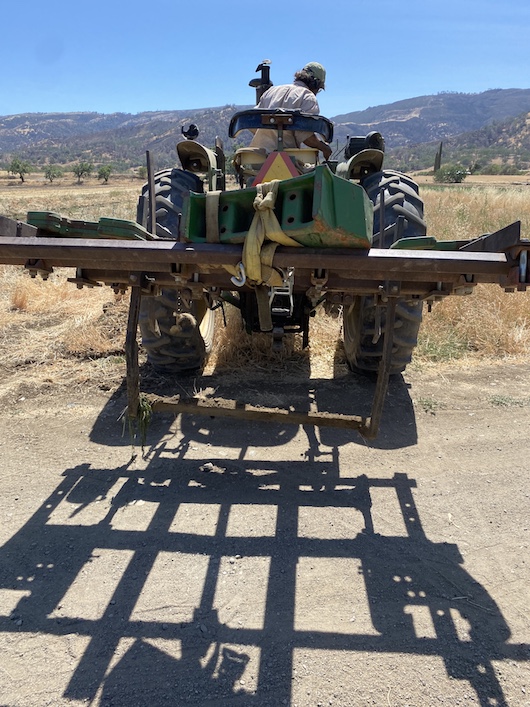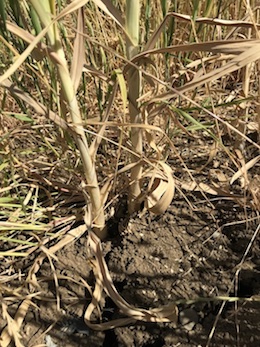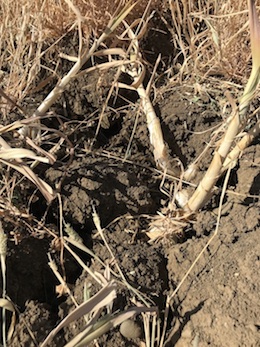This past week was an important one for Full Belly Farm garlic. You’ve been receiving garlic in your boxes since February and have gotten to see its growth and evolution from thin stalks of green garlic that look almost like leeks, to the dried bulbs in the boxes last week that look like “normal” garlic. Our garlic has finally reached the point when it is mature and is ready to be harvested and dried!
So there was a lot of activity happening up in the garlic field last week. I made a few trips up to the field and sat down with Andrew to get some details.
For harvesting, first, we go through each row with a tractor outfitted with undercutter. This fractures soil under and around the bulbs to make them easier to remove. The garlic hasn’t been watered in about a month (more on that later) so the ground is pretty dry and tough.

Andrew Brait on the tractor with the undercutter

Andrew Walker following the tractor inspecting garlic being lifted for hand harvest


Garlic before (left) and after (right) undercutting
After that, the harvest team pulls the garlic out of the ground and puts it into piles (called windrows) and bundles for drying in the field. The garlic will stay this way for approximately a week.

Garlic in a windrow
Then after that week, the garlic is moved to a fully shaded, open-air area for storage. Moisture is the enemy of garlic storage so good airflow is crucial. Then before we use the garlic for CSA boxes or other orders, it needs to be cleaned, which is one of the most labor-intensive parts of handling garlic, which is already pretty labor-intensive.
Even more labor intensive is when we make garlic braids. They’re fragrant and beautiful AND look really difficult to make. Catalina, an experienced braider, said each one takes her about 30 minutes, plus there’s the time to hunt down and process all the flowers. NOTE: we only make these for a couple of weeks and they are only available at our farmers markets.


All of this is just the end of a long process. Garlic is in the ground for 7-8 months. And before we even start the process, we have to acquire the garlic seed. We grow a variety called California Early White. We‘ve grown other varieties in the past but this type works well for our growing conditions and our calendar. There are some varieties that store a bit better, but they mature later and we don’t have the time to harvest and process garlic when we’re in the thick of tomato harvest!
We save and replant some of our garlic but we also buy garlic seed. All garlic is grown by planting a clove from the previous season’s garlic – it doesn’t look like a traditional seed. This nomenclature is the same for potatoes where you plant potatoes to get potatoes, and what you buy to put in the ground are called seed potatoes. We use the purchased garlic seed to produce mature garlic and sometimes green garlic but our own garlic left over from the previous year’s crop is only used for green garlic. Using purchased garlic seed should result in bigger garlic that is more likely to be free of diseases and fungi. The purchased garlic seed is grown at higher elevations and really responds well to our warmer, lower elevation growing conditions. The garlic seed companies size the garlic so we’re able to just get really large cloves, which should result in larger heads with larger cloves. That, plus the time and labor it would take us to prepare 3,000 pounds of seed, and concern about garlic diseases is the reason for purchasing.
For the non-purchased garlic, we vernalize it in the cooler for a month and then get it in the ground by the beginning of September. The main garlic crop doesn’t go into the ground until early/mid October
Once the garlic is in the ground, water is key and is directly proportional to the final size of the garlic. In above average rainfall years, the garlic is huge and in low-rain years, it’s much smaller. We also add water via sprinklers to supplement the rain (definitely necessary this year) and cut off water at the beginning of May, a month before harvest, to start the drying process and to focus the plant’s energy on bulb growth. We also add some supplemental fertilizers to help the garlic, but water is probably the most important factor. And once the garlic starts the drying process, water still is very important, though now it’s bad because it can cause mold and rot the crop. Which we definitely don’t want after all that hard work!
Members of the allium genus (onions, leeks, garlic, shallots, chives) are important ingredients in so much of our cooking, so we always aim to include one in our box when we can. This week our CSA boxes have onions (they go through a similar growing and drying process, but go in the field as transplants), not garlic, but now you’re filled in on how our garlic production and harvest happens!
Elaine Swiedler (with lots of help from Andrew Brait)
CSA Manager
